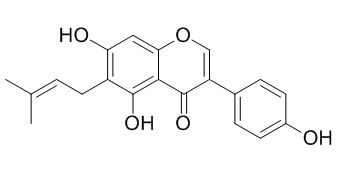Wighteone
Wighteone is an antifungal isoflavone.Wighteone has in vitro cytocidal activity against KB cells, it has a potent anti-proliferative effect on human leukemia HL-60 cancer cell lines, it can effectively inhibit the proliferation of HER2-positive cancer cell lines, and this is considered to be the result of downregulating HSP90 receptor and downstream signaling.
Inquire / Order:
manager@chemfaces.com
Technical Inquiries:
service@chemfaces.com
Tel:
+86-27-84237783
Fax:
+86-27-84254680
Address:
1 Building, No. 83, CheCheng Rd., Wuhan Economic and Technological Development Zone, Wuhan, Hubei 430056, PRC
Providing storage is as stated on the product vial and the vial is kept tightly sealed, the product can be stored for up to
24 months(2-8C).
Wherever possible, you should prepare and use solutions on the same day. However, if you need to make up stock solutions in advance, we recommend that you store the solution as aliquots in tightly sealed vials at -20C. Generally, these will be useable for up to two weeks. Before use, and prior to opening the vial we recommend that you allow your product to equilibrate to room temperature for at least 1 hour.
Need more advice on solubility, usage and handling? Please email to: service@chemfaces.com
The packaging of the product may have turned upside down during transportation, resulting in the natural compounds adhering to the neck or cap of the vial. take the vial out of its packaging and gently shake to let the compounds fall to the bottom of the vial. for liquid products, centrifuge at 200-500 RPM to gather the liquid at the bottom of the vial. try to avoid loss or contamination during handling.
Antibiotics (Basel).2024, 14(1):8.
Biomedicine & Pharmacotherapy2020, 125:109950
Mol Med Rep.2023 Oct;28(4):193.
Redox Biology2024, 103197.
Heliyon.2024, 10(16):e35645.
Appl. Sci.2023, 13(2), 860.
Biocell2023, 47(8):1793-1802
Am J Chin Med.2016, 44(8):1719-1735
Antioxidants (Basel).2020, 9(2):E99
Journal of Ginseng Research2021, 3 June.
Related and Featured Products
Biotechnol Lett. 2006 Jan;28(2):99-105.
Genome-wide analysis of the expression profile of Saccharomyces cerevisiae in response to treatment with the plant isoflavone, wighteone, as a potential antifungal agent.[Pubmed:
16369693]
The limitations of currently available antifungal agents and the rapid emergence of drug-resistant strains necessitate more efficient approaches to screening and developing novel antifungal drugs.
METHODS AND RESULTS:
The antifungal activity of the natural products of a series of plants was evaluated and Wighteone, 5, 7, 4'-trihydroxy-6-(gamma,gamma-dimethylallyl)isoflavone showed excellent anti-yeast activity (MIC against Saccharomyces cerevisiae was 4 microg/ml).
METHODS AND RESULTS:
Transcriptome profiling of Wighteone-treated S. cerevisiae indicated that Wighteone is different from commonly used antifungal compounds in its mode of action.
Phytochemistry. 2001 Dec;58(7):1113-20.
Cytotoxic isoflavones from Erythrina indica.[Pubmed:
11730876]
METHODS AND RESULTS:
Bioassay-directed fractionation of the CH(2)Cl(2)-MeOH (1:1) extract of the stem bark of Erythrina indica, has resulted in the isolation of two new isoflavone derivatives named indicanines D and E together with 11 known compounds including: six isoflavones (genistein, Wighteone, alpinumisoflavone, dimethylalpinumisoflavone, 8-prenyl erythrinin C, and erysenegalensein E), one cinnamate (erythrinassinate B), two pentacyclic triterpenes (oleanolic acid and erythrodiol), and two phytosterols (stigmasterol and its 3-O-beta-D-glucopyranoside).
CONCLUSIONS:
The structures of the new compounds were elucidated by means of spectroscopic analysis. The in vitro cytocidal activity against KB cells of some of the isolated compounds is also reported.
Oncol Lett. 2016 Jun;11(6):3719-3722.
HSP90 expression and its association with wighteone metabolite response in HER2-positive breast cancer cells.[Pubmed:
27313682]
It is well known that heat shock protein 90 (HSP90) overexpression is correlated with poor prognosis and chemo-resistance in human malignant cancers. At the same time, Wighteone, or 6-prenyl-5,7,4'-trihydroxyisoflavone, a major isoflavone component of the ornamental tall tree Erythrina suberosa, has been demonstrated to exhibit a potent anti-proliferative effect on human leukemia HL-60 cancer cell lines.
METHODS AND RESULTS:
In this study, the effects of Wighteone on the proliferation of HER2-positive breast cancer cells were investigated, and the action mechanism was explored. MCF-7 HER2-positive breast cancer cells were treated with various concentrations of Wighteone. The growth inhibitory rate of the cells was calculated by MTT assay, apoptosis was detected by flow cytometry, and the expression level of HSP90 was assessed by western blot analysis. The addition of Wighteone at concentrations ranging from 1-10 g/ml in the medium for 48 h had a marked inhibition on the proliferation of HER2-positive cancer cell lines. The growth inhibitory rates with 0.5, 2 or 8 mM Wighteone were significantly higher compared with the control group. Apoptosis in the Wighteone-treated cells was also significantly higher compared with the control group. The expression level of HSP90 in the Wighteone group was significantly lower than that in the control group.
CONCLUSIONS:
Our findings demonstrated that Wighteone effectively inhibited the proliferation of HER2-positive cancer cell lines, and this is considered to be the result of downregulating HSP90 receptor and downstream signaling.
Nippon Nōgeikagaku Kaishi, 1985, 59(10):1039-1044.
Fungal Metabolites of Antifungal Isoflavone Wighteone.[Reference:
WebLink]
METHODS AND RESULTS:
An antifungal isoflavone, Wighteone [5,7,4′-trihydroxy-6-(3,3-dimethylallyl)isoflavone, 1] was metabolized in cultures of Aspergillus flavus and Botrytis cinerea. The substrate (1) was transformed by the former fungus into 2″, 3″-dihydro-3″-hydroxy Wighteone (Wighteone hydrate, 4) and by the latter into dihydrofurano-isoflavone (2) as major metabolites.
CONCLUSIONS:
A small quantity of dihydropyrano-isoflavone (3), 2 and 2″,3″-dihydrodihydroxyWighteone (5) were detected in the metabolic culture of A.flavus as minor metabolites of 1.
Both 3 and 5 were isolated as Wighteone metabolites in B. cinerea cultures.



